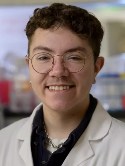A genomics-driven artificial intelligence–based model classifies breast invasive lobular carcinoma and discovers CDH1 inactivating mechanisms Journal Article
| Authors: | Pareja, F.; Dopeso, H.; Wang, Y. K.; Gazzo, A. M.; Brown, D. N.; Banerjee, M.; Selenica, P.; Bernhard, J. H.; Derakhshan, F.; da Silva, E. M.; Colon-Cartagena, L.; Basili, T.; Marra, A.; Sue, J.; Ye, Q.; Da Cruz Paula, A.; Yeni Yildirim, S.; Pei, X.; Safonov, A.; Green, H.; Gill, K. Y.; Zhu, Y.; Lee, M. C. H.; Godrich, R. A.; Casson, A.; Weigelt, B.; Riaz, N.; Wen, H. Y.; Brogi, E.; Mandelker, D. L.; Hanna, M. G.; Kunz, J. D.; Rothrock, B.; Chandarlapaty, S.; Kanan, C.; Oakley, J.; Klimstra, D. S.; Fuchs, T. J.; Reis-Filho, J. S. |
| Article Title: | A genomics-driven artificial intelligence–based model classifies breast invasive lobular carcinoma and discovers CDH1 inactivating mechanisms |
| Abstract: | Artificial intelligence (AI) systems can improve cancer diagnosis, yet their development often relies on subjective histologic features as ground truth for training. Herein, we developed an AI model applied to histologic whole-slide images using CDH1 biallelic mutations, pathognomonic for invasive lobular carcinoma (ILC) in breast neoplasms, as ground truth. The model accurately predicted CDH1 biallelic mutations (accuracy 1⁄4 0.95) and diagnosed ILC (accuracy 1⁄4 0.96). A total of 74% of samples classified by the AI model as having CDH1 biallelic mutations but lacking these alterations displayed alternative CDH1 inactivating mechanisms, including a deleterious CDH1 fusion gene and noncoding CDH1 genetic alterations. Analysis of internal and external validation cohorts demonstrated 0.95 and 0.89 accuracy for ILC diagnosis, respectively. The latent features of the AI model correlated with human-explainable histopathologic features. Taken together, this study reports the construction of an AI algorithm trained using a genetic rather than histologic ground truth that can robustly classify ILCs and uncover CDH1 inactivating mechanisms, providing the basis for orthogonal ground truth utilization for development of diagnostic AI models applied to whole-slide image. Significance: Genetic alterations linked to strong genotypic–phenotypic correlations can be utilized to develop AI systems applied to pathology that facilitate cancer diagnosis and biologic discoveries. ©2024 American Association for Cancer Research. |
| Keywords: | adult; controlled study; gene mutation; major clinical study; genetics; mutation; histopathology; area under the curve; validation process; diagnostic accuracy; sensitivity and specificity; accuracy; phenotype; allele; breast cancer; basal cell carcinoma; cohort analysis; genotype; pathology; breast neoplasms; algorithms; uvomorulin; histology; neuroendocrine tumor; training; algorithm; artificial intelligence; breast tumor; breast carcinoma; fusion gene; genomics; antigens, cd; cancer classification; bioinformatics; cadherin; cadherins; leukocyte antigen; predictive value; receiver operating characteristic; carcinoma, lobular; copy number variation; gray matter; diagnostic test accuracy study; feature extraction; lobular carcinoma; procedures; machine learning; cdh1 protein, human; estrogen receptor positive breast cancer; humans; human; female; article; whole genome sequencing; droplet digital polymerase chain reaction; whole exome sequencing; cross validation; invasive lobular breast carcinoma; learning rate; optimizer; weight decay |
| Journal Title: | Cancer Research |
| Volume: | 84 |
| Issue: | 20 |
| ISSN: | 0008-5472 |
| Publisher: | American Association for Cancer Research |
| Date Published: | 2024-10-15 |
| Start Page: | 3478 |
| End Page: | 3489 |
| Language: | English |
| DOI: | 10.1158/0008-5472.Can-24-1322 |
| PUBMED: | 39106449 |
| PROVIDER: | scopus |
| PMCID: | PMC11479818 |
| DOI/URL: | |
| Notes: | Article -- MSK Cancer Center Support Grant (P30 CA008748) acknowledged in PubMed and PDF -- MSK corresponding author is Fresia Pareja -- Source: Scopus |
Altmetric
Citation Impact
BMJ Impact Analytics
MSK Authors
-
 423
423Riaz -
 309
309Wen -
 287
287Chandarlapaty -
 525
525Brogi -
 136
136Pei -
 646
646Weigelt -
 642
642Reis-Filho -
 148
148Da Cruz Paula -
 228
228Pareja Zea -
 99
99Da Silva -
 188
188Mandelker -
 194
194Selenica -
 102
102Hanna -
 93
93Brown -
 7
7Gill -
 56
56Gazzo -
 31
31Zhu -
 36
36Safonov -
 46
46Marra -
 22
22Derakhshan -
 6
6Ye -
 21
21Green
Related MSK Work






